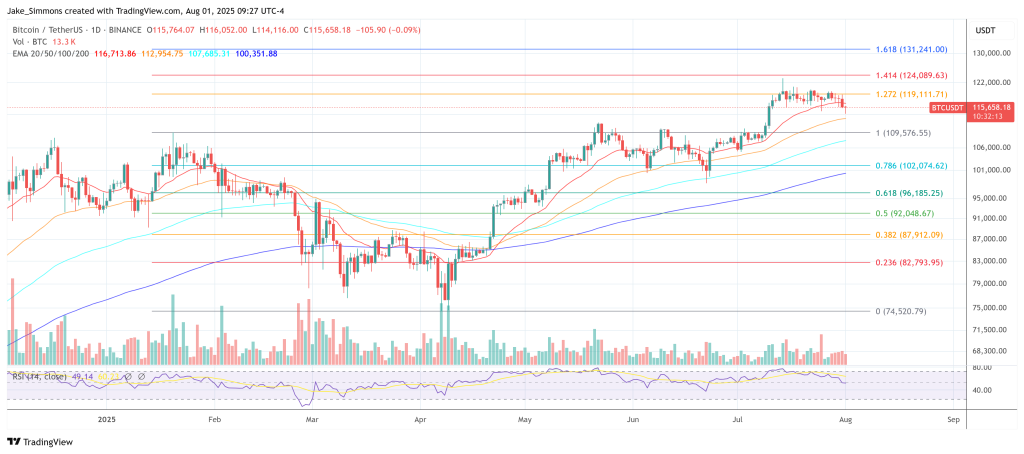On an otherwise ordinary July 31—when the summer heat pressed even the mighty into lethargy—the International Monetary Fund, bastion of measured propriety, did what no Central Planning Apparatus wishes to do: they muttered the truth in a blog post, candid and exhausted as a prisoner writing confessions by weak candlelight. Bitcoin, the prodigal child of decentralized chaos, has blundered into the sanctum of the world’s economic statistics. In obsessive, bureaucratic detail, the IMF admitted: “Bitcoin, for example, has a tangible economic impact, including because it consumes large amounts of energy to produce.” So much effort, and yet, according to the sacred books, not a single legitimate “good” or “service” is birthed. Very well, the IMF said: let us count the fruitless harvest.
So how does the faceless bureaucracy mend its measurement? The compilers—those clerks of history—gathered and, with pen strokes calculated as to avoid direct meaning, decreed that certain crypto assets shall henceforth be “non-produced nonfinancial assets.” A label so sterile, only a committee could love it. But land, rocks, Bitcoin—they all make their mark now in national wealth, alongside more classical treasures and abominations. The alchemy is complete: from outcast, Bitcoin is invited to the grand gala of sovereign spreadsheets. One can almost hear the teeth grinding from Basel to Buenos Aires.
Bitcoin Breaks Into The System (Like a Thief in Broad Daylight)
The Fund’s own social musings—distilled as only PR interns can—delivered what would echo through the cryptoverse: “Bitcoin consumes as much electricity as Argentina but isn’t counted in GDP…” A small reminder that, in the eyes of the keepers, energy is only spent righteously when it matters to the Ministry. Yet, with grim inevitability, the numbers will be tallied. The blog, less a fiery bulletin than an institutional sigh, estimated in 2024 that BTC mining and data centers gobbled up about 2% of global electricity in 2022, with an upward glide toward 3.5% by 2027. Precise enough to terrify climate bureaucrats; vague enough to retain plausible deniability.
Yet, the significance is plain: visibility. The day they measure you, you have been admitted as fact, not heresy. The new Balance of Payments Manual (BPM7)—revised lovingly, one can assume, over stale coffee and existential dread—cements Bitcoin’s place in international statistics. Bitcoin crosses borders now in the clean columns of “non-produced nonfinancial assets.” Even the “validation services” of miners, so long the unspeakable shadow industry, are, at last, promoted to “services,” like accounting or washing windows. Perhaps these, too, will soon require a license.
mining and staking for foreigners now export services; BTC changing hands across borders finds its way, at last, to the capital account. The sector, once off the books, is now a guest at dinner—albeit at the children’s table.
Bitcoin’s partisans wasted no time in waving flags smuggled under their digital mattresses. David Bailey declared, with all the restraint of a man unaccustomed to invitation, that this was “pretty big news”—and that now, the pillars of GDP, trade, and even sovereign credit quality “will now incorporate bitcoin’s economic footprint.” The guardians count all, willing or no, he crowed. We are here, and you can’t look away.
From the fortresses of GreenTech, Jan Wüstenfeld pressed further. For him, the stakes bordered on metaphysical. Bitcoin—and one must grin at the grandiosity—is “the most efficient tool available in turning energy into a lifeline.” Truly nothing transforms electricity into lifeboats so heroically. Somewhere, Nikola Tesla stirs, perhaps out of pride or confusion.
Meanwhile, Daniel Batten, climate watcher and Bitcoin apologist, dismissed the IMF’s energy hand-wringing as tired “FUD,” rallying his digital legion with a simple “Game on.” The moment, for those in the dankest recesses of Bitcoin Twitter, was not scolding but validation: when your enemy counts you, your existence is confirmed.
The Sustainable Bitcoin Protocol delivered the wittiest riposte, decrying the hand-wringing over “energy-intensive” and insisting that this was not a scold, but a coronation. “Bitcoin’s no longer invisible. Even the IMF is forced to measure and report it. That’s legitimization. That’s visibility. That’s macro adoption.” It’s worth considering: in the playbook of the absurd, everything, if observed closely enough, becomes establishment.
But before you uncork victory champagne (or in Bitcoin’s case, twelve-year-old memes), recall: the IMF is not here to endorse your preferred flavor of apocalypse money. The Fund continues its long, plaintive warnings. In El Salvador, it has pressed the authorities—cautiously, with the patience of a torturer—to not accumulate more Bitcoin at the government level, even as the National Bitcoin Office, in a fit of sovereign cheekiness, quietly stockpiles coins. Meanwhile, in Pakistan, the IMF is rumored (again) to have scuttled ideas about subsidized electricity for crypto mining—though, as always, official lips say, “Who, me? Never.”
Yet, amid bureaucratic confusion and denials, the July 31 standards pivot remains, if nothing else, an historic milestone: Bitcoin, the invisible force, is finally measured, cataloged, made official in the world’s ledgers. As for what happens next? The market, as ever, responds—not with applause, but with dollars. At press time, BTC, in its new, IMF-legitimized glory, traded at $115,658. And still—no goods, no services, only a scandal of electrons: the most productive non-production ever measured. 🤷♂️

Read More
- DOGE PREDICTION. DOGE cryptocurrency
- Calvin Harris Announces India Debut With 2 Shows Across Mumbai and Bangalore in November: How to Attend
- EQT Earnings: Strong Production
- The Relentless Ascent of Broadcom Stock: Why It’s Not Too Late to Jump In
- Docusign’s Theatrical Ascent Amidst Market Farce
- TON PREDICTION. TON cryptocurrency
- The Dividend Maze: VYM and HDV in a Labyrinth of Yield and Diversification
- Why Rocket Lab Stock Skyrocketed Last Week
- Ultraman Live Stage Show: Kaiju Battles and LED Effects Coming to America This Fall
- HBO Boss Discusses the Possibility of THE PENGUIN Season 2
2025-08-02 05:44